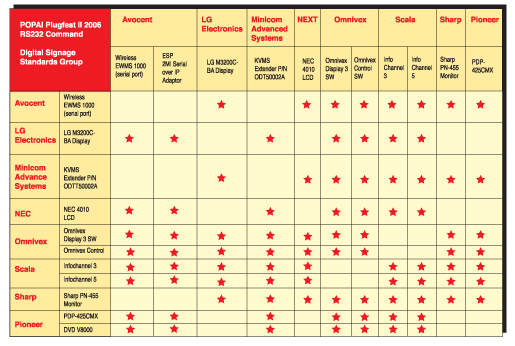- Industry-leading manufacturers in the digital signage market are developing and implementing standards today to help accelerate the industry’s growth. Systems integrators, contractors, and installers of digital signage systems will benefit from these industry- developed standards, but, more to the point, standards will lift demand across the board as endusers will accept more easily puttogether and affordable systems.
- Since the beginning of mass production, industry standards have been used to improve goods and services and make them more efficient. Look around you and the evidence of standards can be seen almost everywhere. From the size of a piece of paper to the 110 volts of electricity used by my computer, standards of many types are present in our daily lives. Henry Ford used standardized parts to help automate his production and enable multiple suppliers to produce individual components. Later, as manufacturing progressed towards standardization, it has enabled multiple companies to work together to offer a variety of solutions for customers.
There are, however, standards that can hinder markets and increase expenses for some manufacturers. Most of the time these types of standards might be imposed to improve the greater good. One example is the recent RoHS standard in Europe; “the restriction of the use of certain hazardous substances in electrical and electronic equipment.” This standard imposed an additional cost to many electronic manufacturers, therefore increasing the cost of their products. On the other hand, the RoHS directive serves as a step towards improving the environment. In the end, it is often the consumer that can benefit the most from standards that are developed to make products better. Better products allow the consumer to have a positive experience that fuels additional product and manufacturer confidence.
Standards for the digital signage market are a work in progress. Lately, that progress has been encouraging. Working together, many different manufacturing companies have recently developed a new industry standard for the command and control of a digital signage display. This particular standard has defined a list of RS232 commands that can get information or perform certain functions. (For example, a simple command for turning on or off a display.) Adhering to the new standard, the display manufacturers will offer the capability for any digital signage software package to issue the same command and be received by a number of different types and models of displays. This will aid systems integrators in being able to utilize different combinations of displays, software, and connectivity to better manage digital signage systems.
Furthering the impact of the new standard for systems integrators, contractors, and the installer community, the POPAI Digital Signage Standards Group has recently conducted their second interoperability and compatibility working session. This testing event, called “Plugfest II,” enabled different manufacturers in the digital signage industry a forum for coming together and testing the new RS232 display command standard. As a result of this event, a compatibility matrix was created to help contractors select equipment and reduce the time needed for individual customer evaluation of a digital signage system.
Moving forward, the Digital Signage Standards Group will continue to find ways to help the industry and the digital signage market. The group is open to many different vendors and partners who have interest in raising the standards of quality throughout the industry and improving the consumer’s experience in the marketplace. The number of companies involved continues to grow from hardware, software, content creation, connectivity, advertisers, media companies, and service providers. Any company that wants the opportunity to participate in the rapidly growing digital signage industry should consider becoming a member.










